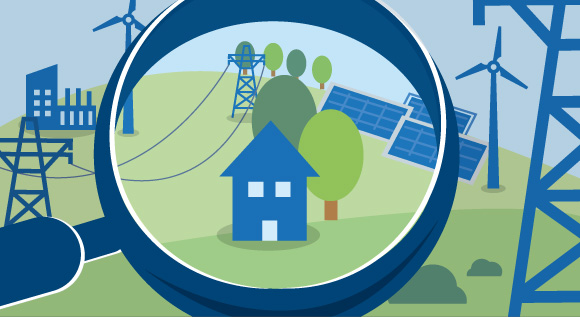What actually is the System Development Strategy?
How can our energy system reliably and rapidly become climate-neutral? The System Development Strategy points the way forward. Follow us on a brief visit to the future of our energy supply.
 © BMWK
© BMWK
This is what it’s all about: our energy system is to become climate-neutral. The System Development Strategy offers a route and a framework for this.
Heading for 2045! Amount of harmful greenhouse gas emissions in Germany: zero. Can we make it, and if so, how? It is true that the greenhouse gas emissions in Germany are falling steadily, but fossil fuels like oil, coal and gas have yet to be consigned to history as mainstays of our energy system.
Three roadmaps to a climate-neutral energy system
The Federal Government has drafted an overarching strategy for this: the System Development Strategy. It is developing a shared vision for a climate-neutral energy system (in German only) and maps out the transformation paths to it. The basis for the System Development Strategy are long-term scenarios covering the energy system up to 2045 and taking account of the climate targets of the Federal Climate Change Act and the Paris Climate Agreement.
The strategy is being drawn up by the Federal Ministry for Economic Affairs and Climate Action in an in-depth dialogue with the energy sector, industry and civil society. The intention is to produce three “route planners”: the vision and the transformation strategy; sector and programme coordination (e.g. with data on the network development plans for electricity, gas and hydrogen); and an overview of further necessary analyses (e.g. on the need for research and development).
Interim report pools findings and sketches out transformation paths
The final text is currently being compiled by the Federal Ministry for Economic Affairs and Climate Action and is to be presented in the first half of 2024. The interim report on the System Development Strategy from November 2023 collates the findings from scenarios, from a technical and systemic viewpoint. These are the key findings of the report for the various aspects of the energy system:
The transformation of industry necessitates deep-reaching changes to production processes in energy-intensive industry. Most process heat can be electrified. As things stand today, hydrogen will be needed in particular for the chemical and steel industry.
In the buildings sector, energy efficiency and improved energy performance, heat pumps and the expansion and conversion of heat networks are particularly important for the reduction of emissions that damage the climate.
In the field of energy provision, wind and photovoltaics, as pillars of the future energy supply, must be very rapidly rolled out. Also, the availability of green hydrogen and hydrogen derivatives should be expanded as quickly as possible. The provision of heat from heat networks must be swiftly and continuously converted to the use of waste heat and renewable energy.
The demands placed on the energy infrastructure will rise in future. In 2045, electricity and hydrogen will mainly be used, i.e. forms of energy that require grid infrastructure. It is correspondingly necessary to significantly expand the electricity grids and to build up infrastructure for hydrogen.
Further information
- More about Germany’s path to climate neutrality (in German only)
- Federal Ministry for Economic Affairs and Climate Action dossier: “The System Development Strategy: a framework for the transformation to a climate-neutral energy system”
- Publication by the Federal Ministry for Economic Affairs and Climate Action: “Interim report on the System Development Strategy” (PDF, 5 MB) (in German only)
- Scientific analyses of the decarbonisation of Germany

